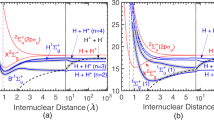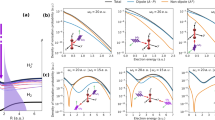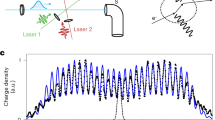Abstract
Quantum coherence-induced effects in atomic and molecular systems are the basis of several proposals for laser-based control of chemical reactions. So far, these rely on coherent photon beams inducing coherent reaction pathways that may interfere with one another, to achieve the desired outcome. This concept has been successfully exploited for removing the inversion symmetry in the dissociation of homonuclear diatomic molecules, but it remains to be seen if such quantum coherent effects can also be generated by the interaction of incoherent electrons with such molecules. Here we show that resonant electron attachment to H2 and the subsequent dissociation into H (n = 2) + H− is asymmetric about the inter-nuclear axis, whereas the asymmetry in D2 is far less pronounced. We explain this observation as due to attachment of a single electron resulting in a coherent superposition of two resonances of opposite parity. In addition to exemplifying a new quantum coherent process, our observation of coherent quantum dynamics involves the active participation of all three electrons and two nuclei, which could provide new tools for studying electron correlations as a means to control chemical processes, and demonstrates the role of coherent effects in electron-induced chemistry.
This is a preview of subscription content, access via your institution
Access options
Access Nature and 54 other Nature Portfolio journals
Get Nature+, our best-value online-access subscription
$29.99 / 30 days
cancel any time
Subscribe to this journal
Receive 12 print issues and online access
$209.00 per year
only $17.42 per issue
Buy this article
- Purchase on Springer Link
- Instant access to full article PDF
Prices may be subject to local taxes which are calculated during checkout




Similar content being viewed by others
References
Tichy, M. C., Mintert, F. & Buchleitner, A. Essential entanglement for atomic and molecular physics. J. Phys. B 44, 192001 (2011).
Rice, S. A. Interfering for the good of a chemical reaction. Nature 409, 422–426 (2001).
Rabitz, H., de Vivie-Riedle, R., Motzkus, M. & Kompa, K. Whither the future of controlling quantum phenomena? Science 288, 824–828 (2000).
Shapiro, M. & Brumer, P. Coherent control of molecular dynamics. Rep. Prog. Phys. 66, 859–942 (2003).
Sansone, G. et al. Electron localization following attosecond molecular photoionization. Nature 465, 763–766 (2010).
Glover, S. C., Savin, D. W. & Jappsen, A.-K. Cosmological implications of the uncertainty in H− destruction rate coefficients. Astrophys. J. 640, 553–568 (2006).
Kreckel, H. et al. Experimental results for H2 formation from H− and H and implications for first star formation. Science 329, 69–71 (2010).
Field, D. H2 formation in space: a negative ion route? Astron. Astrophys. 362, 774–779 (2000).
Fantz, U., Reiter, D., Heger, B. & Coster, D. Hydrogen molecules in the diverter of ASDEX Upgrade. J. Nucl. Mater. 290–293, 367–373 (2001).
Taccogna, F. et al. Plasma–neutral interaction in kinetic models for the divertor region. Contrib. Plasma Phys. 48, 147–152 (2008).
O’ Malley, T. F. Theory of dissociative attachment. Phys. Rev. 150, 14–29 (1966).
Van Brunt, R. J. & Keiffer, L. J. Angular distribution of O− from dissociative electron attachment to O2 . Phys. Rev. A 2, 1899–1905 (1970).
Tronc, M., Fiquet-Fayard, F., Schermann, C. & Hall, R. I. Differential cross sections and angular distributions of H− from dissociative electron attachment to H2 between 3.75 eV and 13 eV. J. Phys. B 10, 305–321 (1977).
Prabhudesai, V. S., Nandi, D. & Krishnakumar, E. On the presence of the 4Σu− resonance in dissociative electron attachment to O2 . J. Phys. B 39, L277–L283 (2006).
Gope, K., Prabhudesai, V. S., Mason, N. J. & Krishnakumar, E. Probing the resonant states of Cl2 using velocity slice imaging. J. Phys. B 49, 015201 (2016).
Krishnakumar, E., Denifl, S., Čadež, I., Markelj, S. & Mason, N. J. Dissociative electron attachment cross sections for H2 and D2 . Phys. Rev. Lett. 106, 243201 (2011).
Čadež, I., Markelj, S., Rupnik, Z. & Pelicon, P. Processes with neutral hydrogen and deuterium molecules relevant to edge plasma in tokamaks. J. Phys. Conf. Ser. 133, 012029 (2008).
Nandi, D., Prabhudesai, V. S., Krishnakumar, E. & Chatterjee, A. Velocity slice imaging for dissociative electron attachment. Rev. Sci. Instrum. 76, 053107 (2005).
Schulz, G. J. Resonances in electron impact on diatomic molecules. Rev. Mod. Phys. 45, 423–487 (1973).
Comer, J. & Read, F. H. Potential curves and symmetries of some resonant states of H2−. J. Phys. B 4, 368–388 (1971).
Weingartshofer, A., Ehrhardt, H., Hermann, V. & Linder, F. Measurements of absolute cross sections for (e, H2) collision processes. Formation and decay of H2− resonances. Phys. Rev. A 2, 204–304 (1970).
Tronc, M., Hall, R. I., Schermann, C. & Taylor, H. S. Interference in dissociative attachment cross sections of H2 around 14 eV. J. Phys. B 12, L279–L282 (1979).
Celiberto, R., Janev, R. K., Wadehra, J. M. & Tennyson, J. Dissociative electron attachment to vibrationally excited H2 molecules involving the 2Σg+ resonant Rydberg electronic state. Chem. Phys. 398, 206–213 (2012).
Stibbe, D. T. & Tennyson, J. Electron–H2 scattering resonances as a function of bond length. J. Phys. B 31, 815–844 (1998).
Sharp, T. E. Potential-energy curves for molecular hydrogen and its ions. At. Data 2, 119–169 (1971).
Martin, F. et al. Single-photon induced symmetry breaking of H2 dissociation. Science 315, 629–633 (2007).
Acknowledgements
We thank B. Nestmann and Y. Sajeev for useful discussions. E.K. acknowledges a Marie Curie Fellowship during the course of the measurements and E.K. and V.S.P. acknowledge the Department of Atomic Energy, India for financial support during the course of the work. N.J.M. recognizes support from the European Union Framework 7 programme LASSIE Marie Curie ITN Grant Agreement 238258 and VAMDC INFRA-2008-1.2.2 Scientific Data Infrastructure. Grant Agreement number: 239108.
Author information
Authors and Affiliations
Contributions
E.K. and N.J.M. planned the research. E.K. built the experiment with help from N.J.M. and carried out the measurements. V.S.P. carried out the simulations and V.S.P. and E.K. interpreted the results. E.K. and V.S.P. prepared the manuscript.
Corresponding author
Ethics declarations
Competing interests
The authors declare no competing financial interests.
Rights and permissions
About this article
Cite this article
Krishnakumar, E., Prabhudesai, V. & Mason, N. Symmetry breaking by quantum coherence in single electron attachment. Nat. Phys. 14, 149–153 (2018). https://doi.org/10.1038/nphys4289
Received:
Accepted:
Published:
Issue Date:
DOI: https://doi.org/10.1038/nphys4289
This article is cited by
-
Inelastic electron scattering induced quantum coherence in molecular dynamics
Nature Communications (2023)
-
Breaking up is hard to do
Nature Physics (2018)



